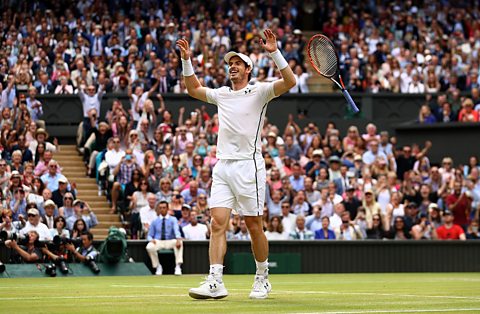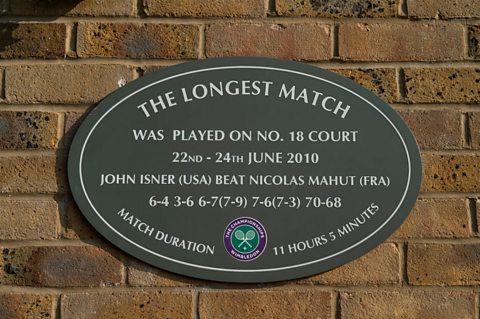Anyone for tennis?
Wimbledon is back! The worldтs most famous tennis tournament takes place for two weeks in south west London with titles galore up for grabs on the hallowed turf.
Want to be an ace at all things Wimbledon this year? ТщЖЙдМХФ Bitesize serves up all you need to know.
How did it all begin?
The first ever Wimbledon took place in 1877, but it was an event very different to the one we know today. There were 22 entrants - all male, as women players were not yet allowed - and the final, won by Spencer Gore, was watched by a crowd of 200 people. Competitors were asked to bring their own racquets and wear shoes without heels. The clubтs gardener provided the balls.
The Ladies Singles was added to the programme in 1884, along with the Menтs doubles.
How does Wimbledon work?
Both the menтs and the womenтs single competitions are made up of 128 players. At the beginning of Wimbledon fortnight they enter a series of single elimination knockout matches, until just two remain in the final.

Itтs not just the singles competitions though. Fifteen titles will be decided at this yearтs Wimbledon т including doubles and mixed doubles, a full wheelchair programme of events and boysт and girlsт tournaments.
There are 18 championship grass courts at Wimbledon, and an order of play is made each day to determine which matches from which competitions will take place across them.
How is it different from other tennis competitions?
There are four tennis championships in the sporting calendar classed as тmajorsт; the US Open, the French Open, the Australian Open - and Wimbledon.
It already stands apart by not being called the British Open, but the two-week championships in London has its own traditions which adds to the Wimbledon atmosphere.
Itтs the only Grand Slam tournament to be played on grass, something that has never changed since 1877. The US and Australian tournaments are played on manufactured hard court surfaces while the French Open is contested on distinctive red clay.
There are strict rules around the grass as well. The turf т made up of 100% rye grass т is grown from April to 15mm in length, then cut down to the perfect playing height of 8mm.
Refrigerated balls - and other quirks
Each of the distinctive yellow balls used at Wimbledon, which weigh 56.7g, is kept at 20 degrees Celsius (68F) before being used in order to ensure a consistency of bounce.
The balls are first changed after seven games, then every nine games т you can even buy a can of match-used ones. Theyтre changed so frequently because they take an enormous amount of pressure. The fastest-ever serve at Wimbledon was produced by American player Taylor Dent in 2010 т an astonishing 148mph. His compatriot Venus Williams has the record for fastest womanтs serve at an equally impressive 129mph two years earlier.
In 2010, USAтs John Isner beat Nicholas Mahut of France in the longest match the sport has ever seen. It took three days to complete and lasted 11 hours and five minutes т pretty much the time it takes to fly from London to Los Angeles.

Eight years later, Isner played another marathon match that lasted over six and a half hours т losing his semi-final to Kevin Anderson. A rule change now means that the final set will go to a tiebreak if level at 12-all and nobody will be more relieved than John Isner.
Stats-wise, who are the Wimbledon legends?
The tournamentтs roll of honour is divided between the champions in the amateur era and those who have won from 1968 onwards т known as the Open Era.
In the menтs singles, Switzerlandтs Roger Federer is the all-time record holder, with eight Wimbledon victories so far, secured between 2003 and 2017. In the amateur era, the UKтs William Renshaw amassed seven titles during the 1880s. Rod Laver of Australia is notable for winning two titles in the amateur years and two in the Open era.
In the Ladiesт singles, the USAтs Martina Navratilova is the all-time leader with nine titles won between 1978 and 1990. In the amateur era, the USAтs Helen Wills Moody came closest to Navratilovaтs tally, with eight victories between 1927 and 1938. Billie Jean King is another legend with wins in both the amateur and Open era; two in the former and four in the latter.
How well have British players done at Wimbledon?
There has been more British success in the Open era in the Ladiesт singles than the Menтs competition. Ann Jones won in 1969, beating Billie Jean King, and Virginia Wade triumphed in 1977.
Fred Perry is a well-known name from sportswear but was also a successful British menтs player, winning three Wimbledon titles in a row from 1934 to 1936.
Tim Henman came incredibly close to the championship match in 2001, beaten in the semi-finals before Andy Murray became the first British man to make the Wimbledon final in 76 years in 2012. He was beaten by Roger Federer on that day, but Murray won the following year, and again in 2016.
This article was published in June 2021 and last updated in 2023

The ultimate guide to Wimbledon jargon
How a let got its name and why it can take years to collect a dinner set

Who inspired these stars to get into tennis?
We have a lot to thank them for.

Five classic Wimbledon traditions
What comes to mind when you think of Wimbledon? We're betting it's these five things.
